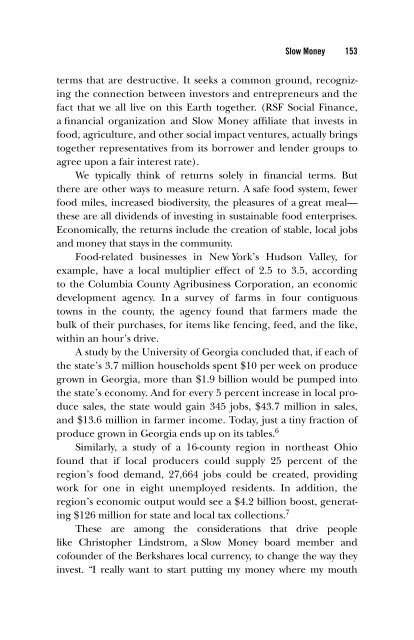3c hapter - Index of
3c hapter - Index of
3c hapter - Index of
You also want an ePaper? Increase the reach of your titles
YUMPU automatically turns print PDFs into web optimized ePapers that Google loves.
Slow Money 153<br />
terms that are destructive. It seeks a common ground, recognizing<br />
the connection between investors and entrepreneurs and the<br />
fact that we all live on this Earth together. (RSF Social Finance,<br />
a fi nancial organization and Slow Money affi liate that invests in<br />
food, agriculture, and other social impact ventures, actually brings<br />
together representatives from its borrower and lender groups to<br />
agree upon a fair interest rate).<br />
We typically think <strong>of</strong> returns solely in fi nancial terms. But<br />
there are other ways to measure return. A safe food system, fewer<br />
food miles, increased biodiversity, the pleasures <strong>of</strong> a great meal—<br />
these are all dividends <strong>of</strong> investing in sustainable food enterprises.<br />
Economically, the returns include the creation <strong>of</strong> stable, local jobs<br />
and money that stays in the community.<br />
Food- related businesses in New York’s Hudson Valley, for<br />
example, have a local multiplier effect <strong>of</strong> 2.5 to 3.5, according<br />
to the Columbia County Agribusiness Corporation, an economic<br />
development agency. In a survey <strong>of</strong> farms in four contiguous<br />
towns in the county, the agency found that farmers made the<br />
bulk <strong>of</strong> their purchases, for items like fencing, feed, and the like,<br />
within an hour’s drive.<br />
A study by the University <strong>of</strong> Georgia concluded that, if each <strong>of</strong><br />
the state’s 3.7 million households spent $10 per week on produce<br />
grown in Georgia, more than $1.9 billion would be pumped into<br />
the state’s economy. And for every 5 percent increase in local produce<br />
sales, the state would gain 345 jobs, $43.7 million in sales,<br />
and $13.6 million in farmer income. Today, just a tiny fraction <strong>of</strong><br />
produce grown in Georgia ends up on its tables. 6<br />
Similarly, a study <strong>of</strong> a 16-county region in northeast Ohio<br />
found that if local producers could supply 25 percent <strong>of</strong> the<br />
region’s food demand, 27,664 jobs could be created, providing<br />
work for one in eight unemployed residents. In addition, the<br />
region’s economic output would see a $4.2 billion boost, generating<br />
$126 million for state and local tax collections. 7<br />
These are among the considerations that drive people<br />
like Christo pher Lindstrom, a Slow Money board member and<br />
c<strong>of</strong>ounder <strong>of</strong> the Berkshares local currency, to change the way they<br />
invest. “I really want to start putting my money where my mouth
















